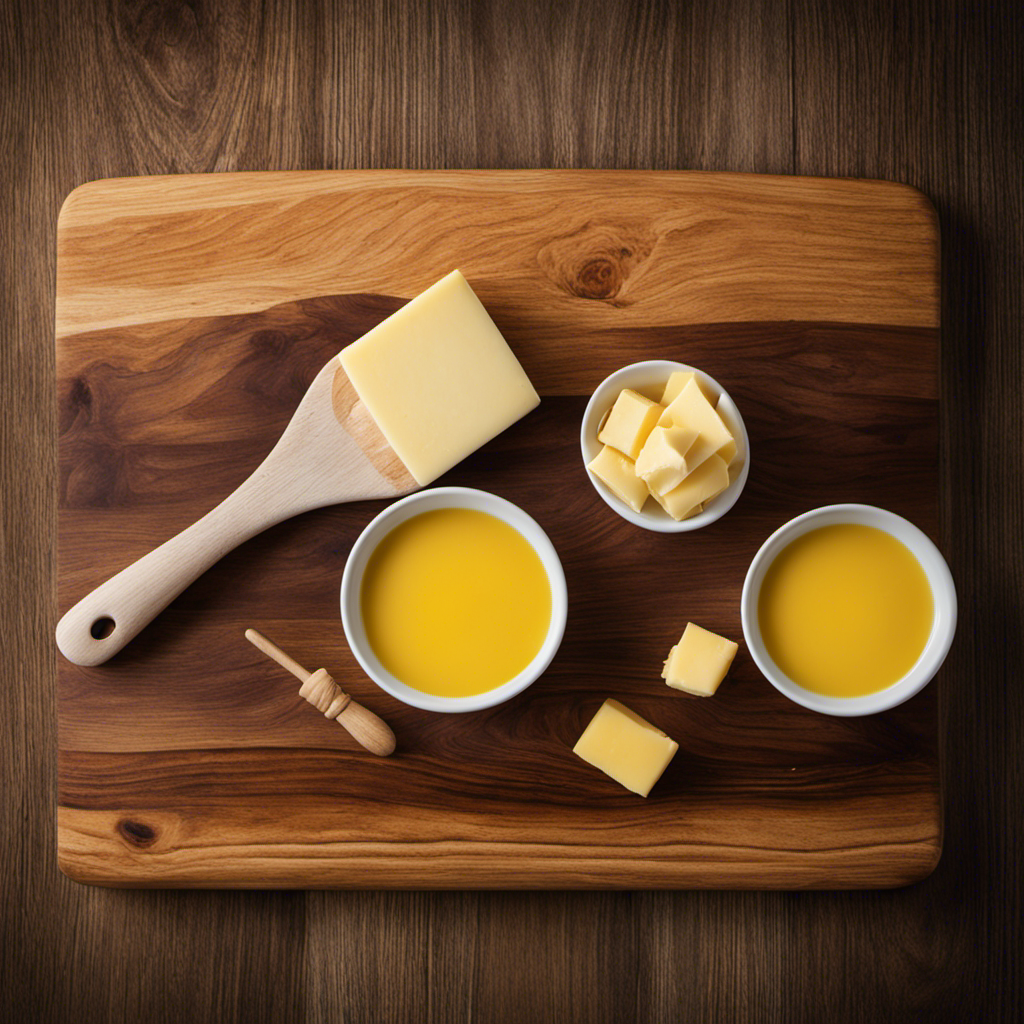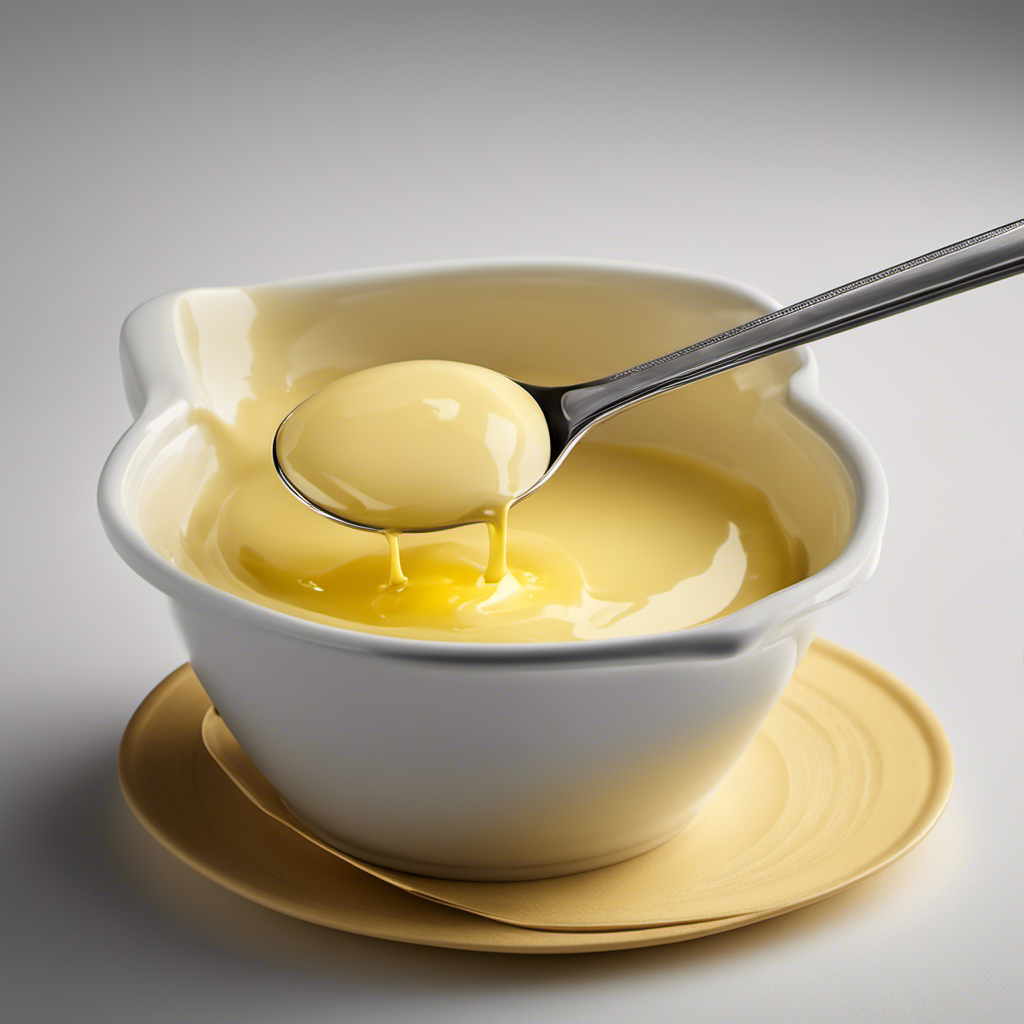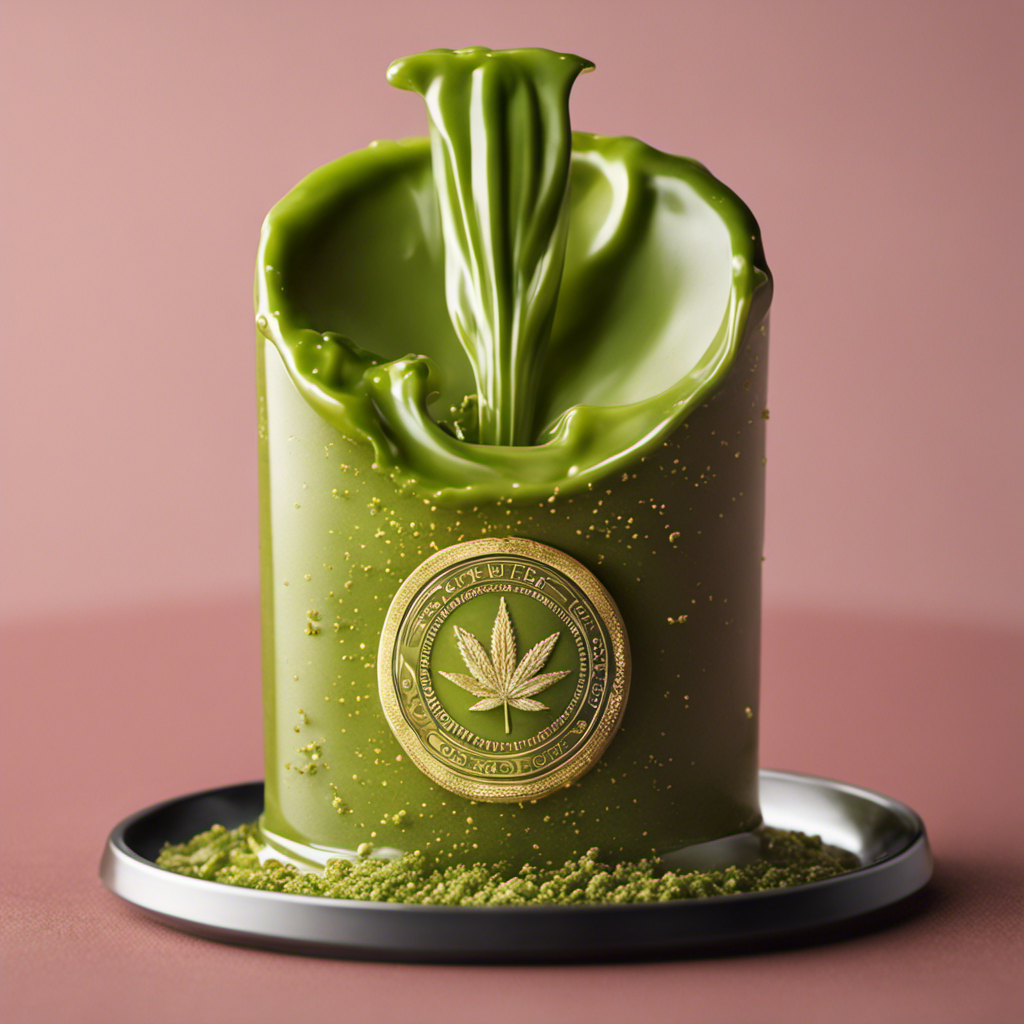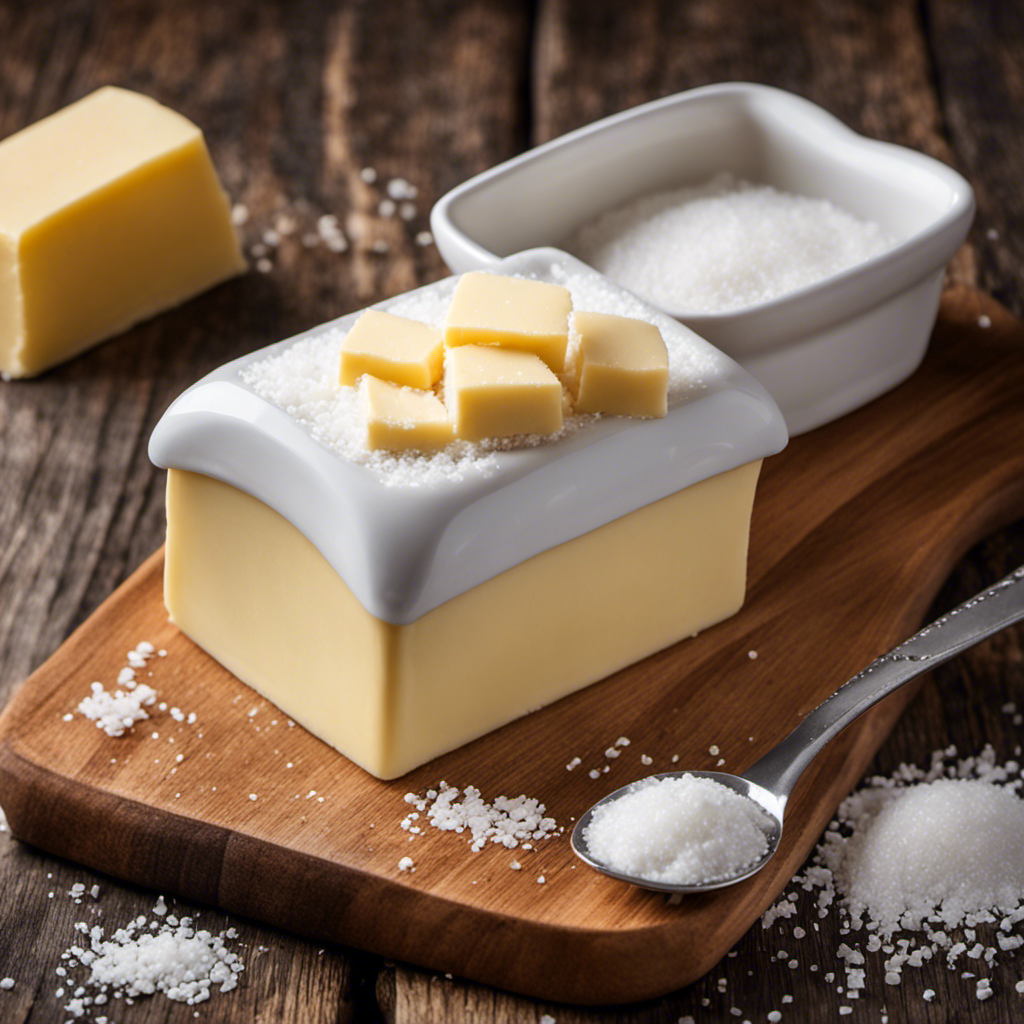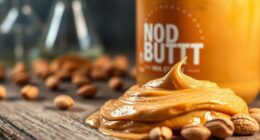Baking has always been a passion of mine, yet there remains one aspect that consistently proves to be a challenge – determining the measurement of stick butter. It feels akin to resolving a riddle. Exactly how many tablespoons can be found in a single stick of butter?
I’ve spent countless hours searching for the answer, but now I want to share what I’ve learned with you. In this article, we’ll dive into the conversion factors, tips, and tricks to help you confidently measure stick butter in tablespoons.
So let’s roll up our sleeves and get ready to bake up a storm!
Key Takeaways
- There are 8 tablespoons in a stick of butter.
- 1/2 a cup of butter is equivalent to 1 stick of butter or 8 tablespoons.
- To convert tablespoons of butter to sticks, divide the number of tablespoons by 8.
- Stick butter measurements are essential for recipe accuracy.
Conversion Factors for Butter Sticks
There are 8 tablespoons in a stick of butter.
Understanding butter equivalences and converting butter measurements is essential in cooking and baking.
When it comes to recipes, it’s important to know how to accurately measure and convert butter quantities.
For example, if a recipe calls for 1/2 a cup of butter, you can easily determine that it is equivalent to 1 stick of butter or 8 tablespoons.
Similarly, if a recipe asks for 12 tablespoons of butter, you can calculate that it is equivalent to 1 and a half sticks of butter.
By understanding these conversions, you can ensure that your recipes turn out just right.
Understanding Butter Measurements
Understanding the measurements for butter can be tricky. It’s important to measure accurately, especially when baking. Here are some tips for measuring butter accurately:
- Use a kitchen scale: Weighing the butter will give you the most accurate measurement.
- Read the package: Many butter packages have markings to indicate tablespoons or cups.
- Soften the butter: If a recipe calls for softened butter, make sure to measure after it has softened.
- Adjust for different forms: If a recipe calls for melted butter but you only have solid butter, use a conversion chart or online calculator to adjust the quantity.
By following these tips, you can ensure that your butter measurements are accurate and your recipes turn out perfectly.
Happy baking!
Tablespoons to Stick Butter Conversion
To convert tablespoons of butter to sticks, simply divide the number of tablespoons by 8. It’s a simple calculation that can be handy when adjusting recipes or calculating butter portions.
When I first started cooking, I found it confusing to figure out how much butter I needed for a recipe that called for sticks. But once I learned this conversion, it became much easier.
For example, if a recipe calls for 16 tablespoons of butter, you would divide that by 8 to get 2 sticks. This knowledge has saved me time and frustration in the kitchen. Now I can confidently adjust recipes without worrying about getting the butter measurements wrong.
Calculating Butter Portions for Recipes
When it comes to baking, butter is a key ingredient that can make or break a recipe. But how do you accurately measure and convert butter for your recipes?
In this discussion, we will explore a conversion table for butter, learn tips for measuring butter accurately, and discover how to adjust recipes to accommodate different amounts of butter.
Conversion Table for Butter
You can easily find the conversion table for butter to know how many tablespoons are in a stick. This table provides valuable information for anyone who loves to cook or bake.
Here are some key points to consider when using the conversion table:
- 1 stick of butter is equal to 8 tablespoons.
- If a recipe calls for 1/2 cup of butter, you can use 1 stick or 8 tablespoons.
- To convert a recipe that uses grams or ounces of butter, use the following conversion factor: 1 stick of butter is approximately 113 grams or 4 ounces.
- It’s important to note that butter measurements can vary slightly depending on the brand, so always refer to the specific conversion table provided by the manufacturer.
Having this knowledge of equivalent measurements will ensure that your recipes turn out perfectly every time.
Measuring Butter Accurately
For accurate measurements of butter, it’s important to be mindful of the slight variations in butter quantities based on different brands. When it comes to measuring butter alternatives, such as margarine or oil, it’s essential to have precise measurements to achieve the desired results in your recipes.
Here are a few tips for measuring butter accurately. First, use a kitchen scale to weigh the butter, as this will provide the most accurate measurement. If you don’t have a kitchen scale, you can use a measuring cup with tablespoon markings. Remember to pack the butter firmly into the cup and level off the top with a straight edge.
Additionally, if your recipe calls for melted butter, measure it after melting rather than before. These simple tips will ensure that your butter measurements are spot-on, guaranteeing delicious and consistent results in your baking and cooking endeavors.
Adjusting Recipes for Butter
To adjust recipes for butter, it’s helpful to substitute with alternative ingredients like margarine or oil if you’re looking for a healthier option. Here are some tips for adjusting butter measurements and converting butter portions:
-
Use margarine: Margarine is a common substitute for butter in many recipes. It has a similar texture and taste, making it an easy swap.
-
Try oil: Another option is to use oil instead of butter. Olive oil or vegetable oil can be used in baking or cooking to reduce the amount of butter needed.
-
Use a butter substitute: There are also specific butter substitutes available in stores that can be used in recipes. These substitutes are often made from plant-based oils and have a similar texture to butter.
-
Adjust the quantities: If you’re looking to reduce the amount of butter in a recipe, try reducing it by half and replacing it with the alternative ingredient of your choice. This can help to lower the overall fat content while still maintaining the desired texture and taste.
Common Measurements for Stick Butter
There’s typically 8 tablespoons in a stick of butter. When it comes to calculating butter quantities in recipes, it’s important to know the common butter measurements.
While a stick of butter is equivalent to 8 tablespoons, it can also be measured in other ways. For example, it is also equal to 1/2 cup or 4 ounces. These measurements are essential when following recipes that call for specific amounts of butter.
Whether it’s for baking cookies, making a creamy sauce, or adding richness to a dish, having the right amount of butter is crucial for achieving the desired result. So, the next time you’re in the kitchen and need to measure butter, keep in mind these common measurements to ensure your recipe turns out perfectly.
How to Measure Stick Butter in Tablespoons
When it comes to baking, understanding the conversion ratio for stick butter is essential.
As someone who loves to whip up delicious treats in the kitchen, I often find myself needing to convert stick butter measurements to alternative measurements.
Whether it’s tablespoons, grams, or cups, knowing how to accurately measure stick butter ensures that my recipes turn out perfectly every time.
Conversion Ratio for Stick Butter
The conversion ratio for stick butter is 8 tablespoons. When it comes to measuring stick butter, it’s important to understand the equivalents.
Here’s a butter conversion chart to help you out:
- 1 stick of butter = 8 tablespoons
- 1/2 stick of butter = 4 tablespoons
- 1/4 stick of butter = 2 tablespoons
- 1/8 stick of butter = 1 tablespoon
Knowing these equivalents can be incredibly helpful when following recipes or trying to convert measurements. Whether you need to halve a stick of butter or just want to know how much butter you have left in tablespoons, this chart will come in handy.
Now that you have a better understanding of the conversion ratio for stick butter and the butter equivalents, let’s explore alternative measurements for stick butter.
Alternative Measurements for Stick Butter
To explore alternative measurements for stick butter, you can try using different units of measurement such as cups or grams. Calculating butter portions can be a bit tricky, especially when recipes call for specific measurements. Adjusting butter measurements can ensure the perfect consistency and flavor in your dishes.
When using cups, one stick of butter is equivalent to 1/2 cup or 8 tablespoons. If you prefer to use grams, a stick of butter weighs approximately 113 grams. These alternative measurements can be helpful when you don’t have a stick of butter on hand or if you prefer to work with different units.
Now, let’s move on to some handy tips for accurate butter measurements.
Handy Tips for Accurate Butter Measurements
You can easily measure butter accurately by using a kitchen scale. It’s a handy tool that ensures precise measurements every time.
Here are some tips to help you achieve accurate butter measurements:
-
Use a kitchen scale: Weighing the butter will give you the most accurate measurement, especially when it comes to calculating butter ratios for recipes.
-
Soften butter properly: When a recipe calls for softened butter, make sure to follow the instructions to achieve the desired consistency. Softened butter measures differently than cold butter.
-
Butter substitution: If you run out of butter, you can substitute it with other ingredients like margarine, shortening, or oil. Just be aware that the texture and taste may vary slightly.
-
Butter measurement equivalents: Knowing the different measurements for butter can be helpful. For example, one stick of butter is equal to 8 tablespoons or 1/2 cup.
Converting Stick Butter to Tablespoons
By knowing the equivalent measurements, it’s easy to convert stick butter into tablespoons. When it comes to baking or cooking, having the right measurements is crucial for a successful dish. Converting stick butter to tablespoons is a common task in the kitchen.
To make this conversion, it’s important to know that one stick of butter is equivalent to 8 tablespoons. This means that if a recipe calls for 1 stick of butter, you can simply use 8 tablespoons instead.
Additionally, if you need to convert stick butter to grams, one stick is equal to 113 grams. And if you prefer using ounces, one stick of butter is approximately 4 ounces.
Knowing these conversions will help you accurately measure stick butter for your culinary endeavors.
Frequently Asked Questions
Can I Substitute Margarine for Stick Butter in a Recipe?
Sure, you can substitute margarine for stick butter in a recipe. It’s important to consider the pros and cons. Margarine can be a healthier option, but it may affect the taste and texture of your dish. Experiment and find what works best for you!
How Do I Measure Stick Butter if I Don’t Have a Tablespoon?
If I don’t have a tablespoon, there are alternative measurements for stick butter. I can use a kitchen scale to weigh it, or I can use the markings on the wrapper to estimate tablespoons.
What Is the Difference Between Salted and Unsalted Stick Butter?
The difference between salted and unsalted butter lies in the presence of salt. Salted butter contains added salt for flavor, while unsalted butter does not. Nutritionally, the main difference is the sodium content.
Can I Use a Different Type of Fat, Like Oil, Instead of Stick Butter in a Recipe?
Yes, you can substitute oil for stick butter in baking. However, keep in mind that the texture and taste may be affected. Other alternative fats for baking include margarine and shortening. Experiment to find the best option for your recipe.
How Can I Soften Stick Butter Quickly for Baking Purposes?
To quickly soften stick butter for baking, I usually cut it into smaller pieces and leave it at room temperature for a few minutes. As for alternative fats, you can use oil or margarine as a substitute in some recipes.
Conclusion
In conclusion, understanding the conversion of tablespoons to stick butter is essential for accurate measurements in recipes. By knowing that there are 8 tablespoons in a stick of butter, you can easily calculate the amount needed for your culinary creations.
However, it is important to investigate the truth behind this theory. Is it always accurate? Are there any exceptions? Further research is needed to add a level of sophistication to our understanding of this conversion factor.
So, next time you’re baking, remember to measure your stick butter in tablespoons for precise results!

